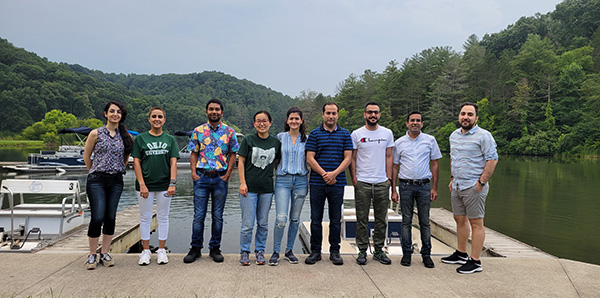When he joined the Ohio University faculty in 2015, Sumit Sharma found a new application for his expertise in molecular modeling and simulations: understanding pipeline corrosion.
The university’s Institute for Corrosion and Multiphase Technology investigates the causes of—and solutions for—this costly problem for the oil and gas industry. Although energy companies had been adding corrosion inhibitors to pipelines, the industry wanted to learn more about how the inhibitors work at the molecular level, Sharma said.

Corrosion inhibitors are surfactants, or substances that adhere to the interfaces of oil and water or metal and water. Drawing on his expertise with modeling surfactant behavior, Sharma’s research group developed new tools that can predict how these molecules will adhere to the surface of the metal pipelines. The models help pipeline engineers understand how changing the chemical makeup of the corrosion inhibitors leads to changes in their effectiveness in the field. Understanding the workings of corrosion inhibitors will help reduce unforeseen corrosion-related failures of pipelines, which previously have been linked to numerous accidents that have resulted in the loss of lives, injuries and significant damage to the environment, Sharma said.
“We are working on solving practical engineering problems by studying the underlying basic science that various industries can use, and the use goes beyond the systems that we are studying,” Sharma said about the broad applications of their research approaches.
Because molecules can very densely pack themselves on surfaces, the researchers needed high performance computing power to obtain a close, detailed look at their behavior. Ohio University pointed Sharma to the Ohio Supercomputer Center, which he now uses for molecular simulations. These high-performance simulations consume more than a million CPU hours at OSC in a typical year.
Sharma has two grants from the National Science Foundation (NSF), and so he also makes use of the federal agency’s Extreme Science and Engineering Discovery Environment (XSEDE) computing services to advance his work.
The researcher will continue to harness these various supercomputing resources to tackle other molecular modeling and simulation challenges. Sharma currently is studying how surfactants interface with metallic nanoparticles, which may be used in bioimaging and drug delivery in the human body. Adding surfactants to the nanoparticles can prompt them to form certain shapes that make them useful for applications such as invading and killing cancer cells. The NSF awarded Sharma a prestigious five-year Faculty Early Career Development (CAREER) grant to support the metallic nanoparticles work in 2021.
By Andrea Gibson
About OSC: The Ohio Supercomputer Center (OSC) addresses the rising computational demands of academic and industrial research communities by providing a robust shared infrastructure and proven expertise in advanced modeling, simulation and analysis. OSC empowers scientists with the services essential to making extraordinary discoveries and innovations, partners with businesses and industry to leverage computational science as a competitive force in the global knowledge economy and leads efforts to equip the workforce with the key technology skills required for 21st century jobs.